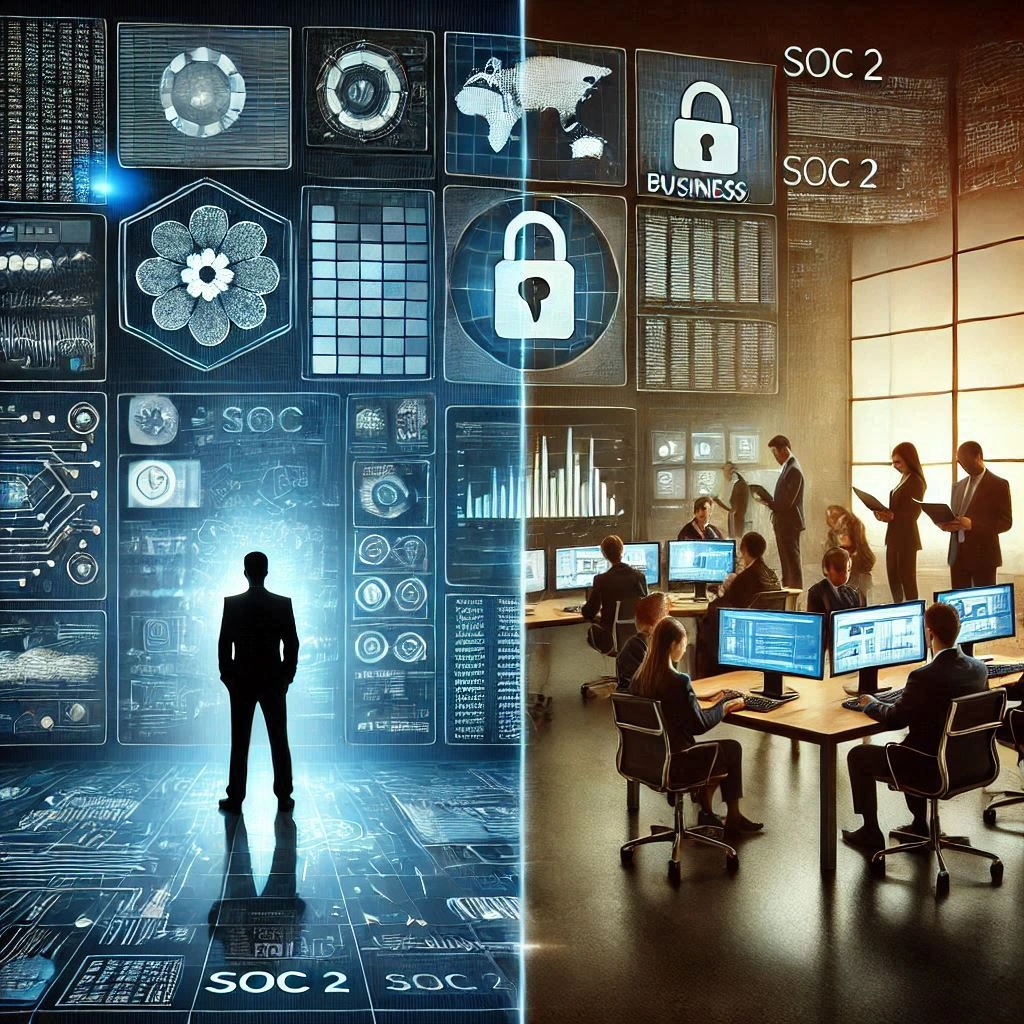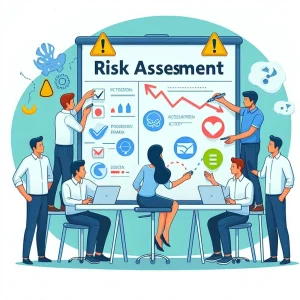Introduction
In today’s rapidly evolving cybersecurity landscape, organizations are increasingly recognizing the importance of robust frameworks to manage and mitigate risks. One such framework is the System and Organization Controls (SOC), which provides a structured approach to evaluating and enhancing an organization’s internal controls related to data security and privacy. SOC frameworks are essential for building trust with stakeholders, ensuring compliance with regulations, and safeguarding sensitive information.
Among the various SOC frameworks, SOC for Cybersecurity and SOC 2 stand out as two distinct yet complementary approaches. SOC for Cybersecurity, introduced in 2017, focuses on an organization’s overall cybersecurity risk management program, providing a comprehensive view of how an organization manages its cybersecurity risks. In contrast, SOC 2 is specifically designed for service organizations, evaluating their controls based on the AICPA’s Trust Services Criteria, which includes security, availability, processing integrity, confidentiality, and privacy.
Understanding the differences between these two frameworks is crucial for CIOs and IT Managers. As leaders responsible for their organization’s cybersecurity posture, they must determine which framework aligns best with their business needs and compliance requirements. By grasping the nuances of SOC for Cybersecurity and SOC 2, CIOs and IT Managers can make informed decisions that enhance their organization’s security measures, build stakeholder confidence, and ultimately drive business success.
Overview of SOC for Cybersecurity
Definition and Objectives
SOC for Cybersecurity is a framework designed to provide organizations with a comprehensive assessment of their cybersecurity risk management programs. It was introduced by the American Institute of Certified Public Accountants (AICPA) to help organizations evaluate their cybersecurity policies, procedures, and controls. The primary objective of SOC for Cybersecurity is to enhance transparency and trust among stakeholders by demonstrating the effectiveness of an organization’s cybersecurity practices. This framework aims to provide assurance that an organization is managing its cybersecurity risks effectively, thereby protecting sensitive data and maintaining operational integrity.
Criteria and Framework
The SOC for Cybersecurity assessment is based on a set of criteria that evaluates an organization’s cybersecurity risk management program against established standards. The framework encompasses several key components, including:
- Governance: Evaluating the organization’s governance structure and its alignment with cybersecurity objectives.
- Risk Assessment: Assessing how the organization identifies and manages cybersecurity risks.
- Control Activities: Reviewing the effectiveness of controls implemented to mitigate identified risks.
- Monitoring: Analyzing the processes in place for ongoing monitoring and improvement of cybersecurity practices.
- Incident Response: Evaluating the organization’s preparedness to respond to cybersecurity incidents.
This structured approach ensures that organizations can systematically address their cybersecurity risks and demonstrate their commitment to maintaining a secure environment.
Intended Audience and Stakeholders
SOC for Cybersecurity reports are tailored for a diverse audience, including:
- CIOs and IT Managers: These stakeholders are primarily interested in understanding the effectiveness of their cybersecurity measures and identifying areas for improvement.
- Board of Directors: The report provides insights into the organization’s cybersecurity posture, helping board members make informed decisions regarding risk management and resource allocation.
- Regulatory Bodies: Organizations may present SOC for Cybersecurity reports to demonstrate compliance with industry regulations and standards.
- Clients and Business Partners: By sharing these reports, organizations can build trust with clients and partners, assuring them that their data is being handled securely.
Overview of SOC 2
SOC 2, or System and Organization Controls 2, is a reporting framework specifically designed for service organizations. It evaluates the effectiveness of an organization’s controls related to information security, availability, processing integrity, confidentiality, and privacy. This framework is particularly relevant for businesses that handle sensitive customer data, as it provides assurance to clients and stakeholders regarding the organization’s commitment to maintaining high standards of data protection and security practices [5][6].
Trust Services Criteria (TSC)
SOC 2 reports are based on the Trust Services Criteria (TSC), which are a set of standards established by the American Institute of Certified Public Accountants (AICPA). The TSC includes five key areas:
- Security: Protection of the system against unauthorized access.
- Availability: The system is available for operation and use as committed or agreed.
- Processing Integrity: System processing is complete, valid, accurate, timely, and authorized.
- Confidentiality: Information designated as confidential is protected as committed or agreed.
- Privacy: Personal information is collected, used, retained, disclosed, and disposed of in conformity with the commitments in the entity’s privacy notice.
These criteria serve as the foundation for assessing the controls in place at a service organization, ensuring that they meet the necessary standards for safeguarding data and maintaining operational integrity [5][6][7].
Target Audience for SOC 2 Reports
The primary audience for SOC 2 reports includes clients, stakeholders, and regulatory bodies who require assurance regarding the service organization’s data management practices. Typical use cases for SOC 2 reports involve:
- Service Providers: Companies that provide cloud services, data hosting, or software as a service (SaaS) often utilize SOC 2 reports to demonstrate their commitment to security and compliance.
- Business Partnerships: Organizations seeking to establish partnerships or contracts with other businesses may request SOC 2 reports to evaluate the security posture of potential partners.
- Regulatory Compliance: Companies in regulated industries may use SOC 2 reports to meet compliance requirements and demonstrate adherence to industry standards.
By understanding the principles and applications of SOC 2, CIOs and IT Managers can better assess whether this framework aligns with their organization’s needs and objectives in managing cybersecurity risks [2][6][8].
Key Differences between SOC for Cybersecurity and SOC 2
When it comes to ensuring robust security and compliance within an organization, understanding the distinctions between SOC for Cybersecurity and SOC 2 is crucial for CIOs and IT Managers. Both frameworks serve important roles in assessing and validating an organization’s controls, but they cater to different needs and focus areas. Here’s a comparative analysis of these two frameworks:
1. Focus Areas: Cybersecurity Risk Management vs. Operational Controls
- SOC for Cybersecurity: This framework is primarily centered on evaluating an organization’s cybersecurity risk management program. It assesses how effectively an organization identifies, manages, and mitigates cybersecurity risks, making it particularly relevant for businesses that prioritize cybersecurity as a core component of their operational strategy [1][10].
- SOC 2: In contrast, SOC 2 focuses on operational controls related to the AICPA’s Trust Services Criteria, which include security, availability, processing integrity, confidentiality, and privacy. This framework is designed to ensure that service organizations manage customer data securely and effectively, making it essential for businesses that handle sensitive information [2][12].
2. Reporting Style and Intended Audience Differences
- SOC for Cybersecurity Reports: These reports are comprehensive and intended for a broad audience, including stakeholders interested in the overall cybersecurity posture of the organization. They provide insights into the effectiveness of the cybersecurity risk management program and are often used to communicate with executive management and the board of directors [7][10].
- SOC 2 Reports: SOC 2 reports are more specialized and typically aimed at clients and business partners. They focus on the specific controls in place to protect customer data and ensure compliance with relevant regulations. The reports are often used to demonstrate trustworthiness and reliability to customers and partners [3][5].
3. Assessment Methodologies and Audit Processes
- Assessment Methodology for SOC for Cybersecurity: The SOC for Cybersecurity examination evaluates the organization as a whole against various major security frameworks. This holistic approach allows for a comprehensive assessment of the organization’s cybersecurity practices and policies, ensuring that all aspects of cybersecurity risk management are considered [11][13].
- Assessment Methodology for SOC 2: The SOC 2 examination, on the other hand, prescriptively evaluates a service organization against the AICPA’s Trust Services Criteria. This involves a detailed examination of the design and operational effectiveness of controls related to security, availability, and confidentiality. The audit process is typically more focused on specific operational controls rather than the broader cybersecurity risk management framework [4][12].
When to Choose SOC for Cybersecurity
In today’s digital landscape, organizations face an increasing array of cybersecurity threats that can jeopardize sensitive data and operational integrity. Understanding when to opt for a SOC for Cybersecurity over a SOC 2 report is crucial for CIOs and IT Managers aiming to align their security frameworks with their business needs. Here are key considerations for choosing SOC for Cybersecurity:
1. Business Environments Requiring a Focus on Cybersecurity Risks
Organizations that operate in high-risk environments, such as those handling sensitive customer data or critical infrastructure, should prioritize SOC for Cybersecurity. This framework is specifically designed to assess and enhance an organization’s cybersecurity risk management program. It provides a comprehensive evaluation of cybersecurity policies, procedures, controls, and practices, ensuring they are effectively designed and operationally sound. If your business is in a sector where data breaches can lead to significant financial loss or reputational damage, SOC for Cybersecurity is the more suitable choice [13].
2. Compliance Needs and Regulatory Requirements
Many industries are subject to stringent regulatory requirements that mandate robust cybersecurity measures. For instance, organizations in finance, healthcare, and government sectors often face regulations that necessitate a thorough examination of their cybersecurity risk management practices. SOC for Cybersecurity provides a rigorous assessment that can help organizations demonstrate compliance with these regulations, making it an essential framework for businesses that must adhere to specific legal and regulatory standards [14].
3. Specific Industries or Sectors Where SOC for Cybersecurity is Advantageous
Certain industries benefit significantly from adopting SOC for Cybersecurity due to the nature of their operations and the sensitivity of the data they handle. These include:
- Financial Services: Given the high stakes involved in financial transactions and data privacy, a SOC for Cybersecurity can help institutions manage risks effectively and comply with regulations like GLBA and PCI DSS.
- Healthcare: With the increasing digitization of health records, healthcare organizations must protect sensitive patient information. SOC for Cybersecurity helps ensure compliance with HIPAA and other healthcare regulations.
- Technology and Cloud Services: Companies providing cloud services or technology solutions often face unique cybersecurity challenges. A SOC for Cybersecurity assessment can help these organizations build trust with clients by demonstrating their commitment to cybersecurity risk management [11][12].
When to Choose SOC 2
Choosing the right SOC framework is crucial for businesses, especially for CIOs and IT Managers who must align their security and operational controls with client expectations and industry standards. SOC 2 is particularly beneficial in specific scenarios where operational controls and service delivery are paramount. Here are some key points to consider when determining if SOC 2 is the right choice for your organization:
- Operational Controls and Service Delivery: SOC 2 is designed for service organizations that handle customer data and require robust operational controls. If your business model relies heavily on delivering services that involve sensitive data, such as cloud computing or SaaS, SOC 2 provides a framework to ensure that your operational controls are effective in safeguarding that data. This is especially important for organizations that prioritize security, availability, and confidentiality in their service delivery [3][4].
- Client and Stakeholder Expectations: Many clients and stakeholders expect transparency regarding how their data is managed and protected. SOC 2 reports serve as a testament to an organization’s commitment to maintaining high standards of data security and privacy. If your clients are particularly concerned about data handling practices, obtaining a SOC 2 report can enhance trust and credibility, demonstrating that your organization adheres to recognized standards [14][10].
- Alignment with Service-Oriented Businesses: SOC 2 is particularly well-suited for service-oriented businesses, especially those in the technology sector, such as SaaS providers. The flexibility of the SOC 2 framework allows organizations to tailor their cybersecurity controls to meet specific operational needs while still adhering to the five Trust Services Criteria: security, availability, processing integrity, confidentiality, and privacy. This adaptability makes SOC 2 an attractive option for businesses that need to align their security practices with their unique service offerings [3][4][6].
Integrating Both Frameworks for Comprehensive Risk Management
In today’s rapidly evolving digital landscape, organizations face an array of cybersecurity threats that necessitate robust risk management strategies. Two prominent frameworks that have emerged to address these challenges are the SOC for Cybersecurity and SOC 2. While each framework serves distinct purposes, integrating both can significantly enhance an organization’s overall security posture. Here’s a closer look at how combining these frameworks can benefit businesses, along with examples and best practices for effective implementation.
Enhancing Overall Security Posture
- Comprehensive Coverage: SOC for Cybersecurity focuses on evaluating an organization’s cybersecurity risk management program, assessing policies, procedures, and controls to ensure they are effective and properly designed [2]. In contrast, SOC 2 emphasizes the operational effectiveness of controls related to security, availability, processing integrity, confidentiality, and privacy [11]. By leveraging both frameworks, organizations can achieve a more holistic view of their security landscape, addressing both cybersecurity risks and operational controls.
- Risk Mitigation: The SOC for Cybersecurity framework allows organizations to identify and manage cybersecurity risks at a strategic level, while SOC 2 provides a more granular assessment of specific controls. This dual approach enables businesses to not only comply with regulatory requirements but also proactively mitigate risks that could lead to data breaches or service disruptions.
Best Practices for Implementation
- Define Clear Objectives: Before embarking on the integration of both frameworks, organizations should clearly define their objectives. Understanding the specific risks and compliance requirements relevant to the business will help tailor the assessments effectively [9].
- Collaborative Approach: Encourage collaboration between teams responsible for cybersecurity and those managing compliance with SOC 2. This collaboration can foster a culture of security awareness and ensure that both frameworks are aligned with the organization’s overall risk management strategy.
- Continuous Monitoring and Improvement: Implement a continuous monitoring process to regularly assess the effectiveness of both frameworks. This includes updating policies and controls based on emerging threats and changes in the regulatory landscape. Regular reviews can help organizations stay ahead of potential vulnerabilities and ensure ongoing compliance [12].
- Training and Awareness: Invest in training programs for staff to ensure they understand the importance of both frameworks and their roles in maintaining compliance. A well-informed workforce is crucial for the successful implementation of any risk management strategy.
By integrating SOC for Cybersecurity and SOC 2, organizations can create a comprehensive risk management framework that not only meets compliance requirements but also enhances their overall security posture. This strategic approach not only protects sensitive data but also builds trust with clients and stakeholders, ultimately contributing to the long-term success of the business.
Conclusion
In the evolving landscape of cybersecurity, understanding the distinctions between SOC for Cybersecurity and SOC 2 is crucial for organizations aiming to enhance their security posture and meet compliance requirements. Both frameworks serve vital roles in demonstrating a commitment to data security, yet they cater to different needs and objectives.
- Importance of Understanding Differences: Recognizing the differences between SOC for Cybersecurity and SOC 2 is essential for CIOs and IT Managers. SOC 2 focuses on specific trust services criteria such as security, availability, and confidentiality, making it ideal for service organizations that need to assure clients about their data handling practices. In contrast, SOC for Cybersecurity provides a broader assessment of an organization’s cybersecurity risk management program, which can be beneficial for companies looking to establish a comprehensive cybersecurity strategy [1][12].
- Assessing Business Needs and Compliance Requirements: It is imperative for CIOs and IT Managers to evaluate their unique business needs and compliance obligations when deciding between these frameworks. Factors such as the nature of the services provided, the regulatory environment, and stakeholder expectations should guide this assessment. By aligning the chosen framework with organizational goals, businesses can better manage risks and enhance their overall cybersecurity resilience [11][14].
- Call to Action: As you navigate the complexities of cybersecurity frameworks, consider engaging with experts who can provide tailored insights and support. Whether you are leaning towards SOC for Cybersecurity or SOC 2, consulting with a reputable firm can streamline the assessment process and ensure that your organization meets its security and compliance objectives effectively. Don’t hesitate to reach out for further discussions or consultations regarding your SOC assessments to make informed decisions that will benefit your organization in the long run [10][11].
By taking these steps, CIOs and IT Managers can ensure that their organizations are not only compliant but also well-prepared to face the challenges of today’s cybersecurity landscape.
Find out more about Shaun Stoltz https://www.shaunstoltz.com/about/
This post was written by an AI and reviewed/edited by a human.



